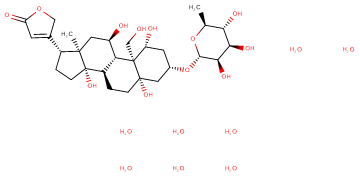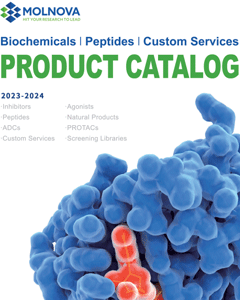
Ouabain octahydrate
CAS No. 11018-89-6
Ouabain octahydrate( —— )
Catalog No. M10391 CAS No. 11018-89-6
Ouabain, A cardioactive glycoside consisting of rhamnose and ouabagenin, obtained from the seeds of Strophanthus gratus and other plants of the Apocynaceae.
Purity : >98% (HPLC)
 COA
COA
 Datasheet
Datasheet
 HNMR
HNMR
 HPLC
HPLC
 MSDS
MSDS
 Handing Instructions
Handing Instructions
| Size | Price / USD | Stock | Quantity |
| 50MG | 50 | In Stock |


|
| 100MG | 70 | In Stock |


|
| 200MG | Get Quote | In Stock |


|
| 500MG | Get Quote | In Stock |


|
| 1G | Get Quote | In Stock |


|
Biological Information
-
Product NameOuabain octahydrate
-
NoteResearch use only, not for human use.
-
Brief DescriptionOuabain, A cardioactive glycoside consisting of rhamnose and ouabagenin, obtained from the seeds of Strophanthus gratus and other plants of the Apocynaceae.
-
DescriptionOuabain, A cardioactive glycoside consisting of rhamnose and ouabagenin, obtained from the seeds of Strophanthus gratus and other plants of the Apocynaceae; used like digitalis. It is commonly used in cell biological studies as an inhibitor of the NA-K(+)-exchanging ATPase. (In Vitro):Ouabain (100 μM) induces NLRP3 inflammasome activation and IL-1β release in macrophages. Ouabain-induced NLRP3 inflammasome activation is mediated through K+ efflux. Ouabain (3 nM) alters the expression of EMT markers in NHK and ADPKD cells, and modifies cell-cell adhesion properties in ADPKD. Moreover, ouabain enhances migration of ADPKD cells, selectively modulates tight junctions, and modulates adherens junctions in ADPKD cells in a selective manner. Ouabain also activates TGFβ-Smad3 signaling, alters TER in ADPKD cells. Ouabain (25, 50 or 100 nM) treatment significantly reduces cell proliferation and viability in Raji cells in a dose-dependent manner, with IC50 of 76.48±4.03 nM. Ouabain increases the number of apoptotic cells, induces autophagy, and upregulates Beclin-1 in Raji cells. (In Vivo):Ouabain (3 mg/kg) significantly decreases cardiac contractile force with an enlarged LVESD when mice are primed with LPS. IL-1β deficiency attenuates ouabain-induced cardiac dysfunction and injury. IL-1β secreted by infiltrated macrophages contributes to ouabain-induced cardiac inflammation. Deficiency of NLRP3 and Casp1 attenuates ouabain-induced cardiac dysfunction and macrophage infiltration. Ouabain (30 μg/kg, i.p.) modulates ABCB1 activity in thymocytes of Wistar rats and it has the same effect on Swiss mice at 300 μg/kg. After 14 days of ouabain treatment, the MAP of rats is significantly elevated.
-
In VitroOuabain (100 μM) induces NLRP3 inflammasome activation and IL-1β release in macrophages. Ouabain-induced NLRP3 inflammasome activation is mediated through K+ efflux. Ouabain (3 nM) alters the expression of EMT markers in NHK and ADPKD cells, and modifies cell-cell adhesion properties in ADPKD. Moreover, ouabain enhances migration of ADPKD cells, selectively modulates tight junctions, and modulates adherens junctions in ADPKD cells in a selective manner. Ouabain also activates TGFβ-Smad3 signaling, alters TER in ADPKD cells. Ouabain (25, 50 or 100 nM) treatment significantly reduces cell proliferation and viability in Raji cells in a dose-dependent manner, with IC50 of 76.48±4.03 nM. Ouabain increases the number of apoptotic cells, induces autophagy, and upregulates Beclin-1 in Raji cells.
-
In VivoOuabain (3 mg/kg) significantly decreases cardiac contractile force with an enlarged LVESD when mice are primed with LPS. IL-1β deficiency attenuates ouabain-induced cardiac dysfunction and injury. IL-1β secreted by infiltrated macrophages contributes to ouabain-induced cardiac inflammation. Deficiency of NLRP3 and Casp1 attenuates ouabain-induced cardiac dysfunction and macrophage infiltration. Ouabain (30 μg/kg, i.p.) modulates ABCB1 activity in thymocytes of Wistar rats and it has the same effect on Swiss mice at 300 μg/kg. After 14 days of ouabain treatment, the MAP of rats is significantly elevated.
-
Synonyms——
-
PathwayEndocrinology/Hormones
-
TargetATPase
-
RecptorNa+/K+-ATPase
-
Research AreaCardiovascular Disease
-
Indication——
Chemical Information
-
CAS Number11018-89-6
-
Formula Weight728.77
-
Molecular FormulaC29H44O12·8H2O
-
Purity>98% (HPLC)
-
SolubilityDMSO: 10 mM
-
SMILESC[C@H]1[C@@H]([C@H]([C@H]([C@@H](O1)O[C@H]2C[C@H]([C@@]3([C@@H]4[C@@H](CC[C@@]3(C2)O)[C@]5(CC[C@@H]([C@]5(C[C@H]4O)C)C6=CC(=O)OC6)O)CO)O)O)O)O.O.O.O.O.O.O.O.O
-
Chemical Name——
Shipping & Storage Information
-
Storage(-20℃)
-
ShippingWith Ice Pack
-
Stability≥ 2 years
Reference



-
Paederosidic acid me...
Paederosidic acid methyl ester has antinociception, is possibly related to the pathway of NO-cGMP-ATP sensitive K(+) channels.
-
Bacoside A3
Bacoside A3 is one of the components of Bacopa monnieri (L.) Wettst. bacoside A with antioxidant potential. Bacoside A3 shows comparatively higher neuroprotective response analysed as higher cell viability and decreased intracellular ROS.
-
3′,4′,7-Trihydroxyfl...
7,3',4'-Trihydroxyflavone inhibits osteoclastogenesis via the nuclear factor of activated T cells c1. 7,3',4'-Trihydroxyflavone can markedly inhibit the receptor activator of nuclear factor kappa B ligand-induced osteoclastic differentiation from mouse bone marrow-derived macrophages (BMMs).



 Cart
Cart
 sales@molnova.com
sales@molnova.com


